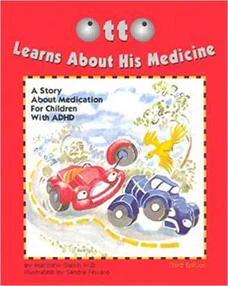Otto Learns About His Medicine
A Story about Medication for Children with ADHD
Written by Matthew Galvin
Illustrated by Sandra Ferraro
32 pages
•
Published 2001 (Magination Press, 3rd Edition)

Recommended Age Range: Kindergarten through 2nd grade.
Publisher's Summary:
Otto, a fidgety young car that has trouble paying attention in school, visits a special mechanic who prescribes a medicine to control his hyperactive behavior.

Dr. Annie's Takeaways
Recommended for: This book is best for a child who has recently been diagnosed with ADHD. It is a surprisingly charming, car-themed overview of ADHD and its treatment. It reviews common symptoms of ADHD (including hyperactivity and inattention), the process of getting evaluated and diagnosed with ADHD (in this book the diagnosis is a motor that runs too fast), and treatment with a psychologist and a psychiatrist–“special mechanics” who are part of young Otto Mobile’s “pit crew.” It describes behavioral and medication interventions and provides hope that a child’s own pit crew will help them run to the best of their ability.
Tone: Encouraging, informative
Story Quality: This book is too long for its target audience. However, it is far more charming than its terribly un-charming title suggests. It’s a book about a young car (Otto Mobile–the puns start early!) who struggles with inattention and impulsivity. He has a “pit crew” of “special mechanics” who help him learn to manage his fast motor. The title suggests the book is all about medication, but that’s really only a small piece of the story. It’s a story about a kid with ADHD and the process of getting an evaluation, diagnosis, therapy, and medication. But the kid is a car, and the story is filled with car references and puns, which makes it a lot more engaging than it would be otherwise.
Illustrations: Primary colored watercolor illustrations of anthropomorphized cars.
Representation: Otto is an anthropomorphized male car with a mom and a dad. No diagnoses are used, but he exhibits hyperactive and inattentive symptoms of ADHD. He struggles to pay attention to his teacher, has working memory challenges, acts impulsively, and has a hard time staying still. He has a female psychologist, a male psychiatrist, and a male teacher.
Psychological Practices: This book is a kid-friendly overview of the process of getting diagnosed with ADHD and the treatment that follows. It is empathetic towards its automotive protagonist, and it is thorough in its descriptions (perhaps too thorough–the book is a bit long). It first describes common symptoms of ADHD and how these get in the way for Otto. Otto’s parents are concerned and take him to a “special mechanic” who gives Otto’s parents and teacher (Mr. Jalopy) forms to fill out (as happens in a evaluation with a psychologist). She then speaks with Otto about his experiences and diagnoses him with a motor that goes too fast. She tells him and his parents that she will help Otto learn how to tell what is most important to pay attention to, how to keep track of things, and how to get along better with other cars. She explains that she, Otto’s parents, his teacher, and another special mechanic (Dr. Beemer) will be his “pit crew” to help him to run the best that he can. Dr. Beemer also asks Otto lots of questions and does a physical exam. He prescribes Otto a medication which he explains will help Otto to “be a better listener and choose to stay still.” He clarifies that even with the medication, Otto will still need to learn things like when to go fast and when to go slow and that his pit crew will help him to learn these things. Dr. Beemer explains that the medication could have side effects of making Otto less hungry or less sleepy but that he would help Otto and his parents manage these side effects (e.g., by having Otto take the medicine at particular times of the day). The book ends, a bit abruptly, with Otto successfully crossing a finish line.
Concerns: The primary problem with this book is that it really has a lot of words for a book written for young kids with ADHD. It might be better broken up into chapters and read over a couple of days rather than in one sitting. It might work well to read the relevant pages (e.g., the visit to the “special mechanic” psychologist) prior to or following a child’s experience with that part of the process.
